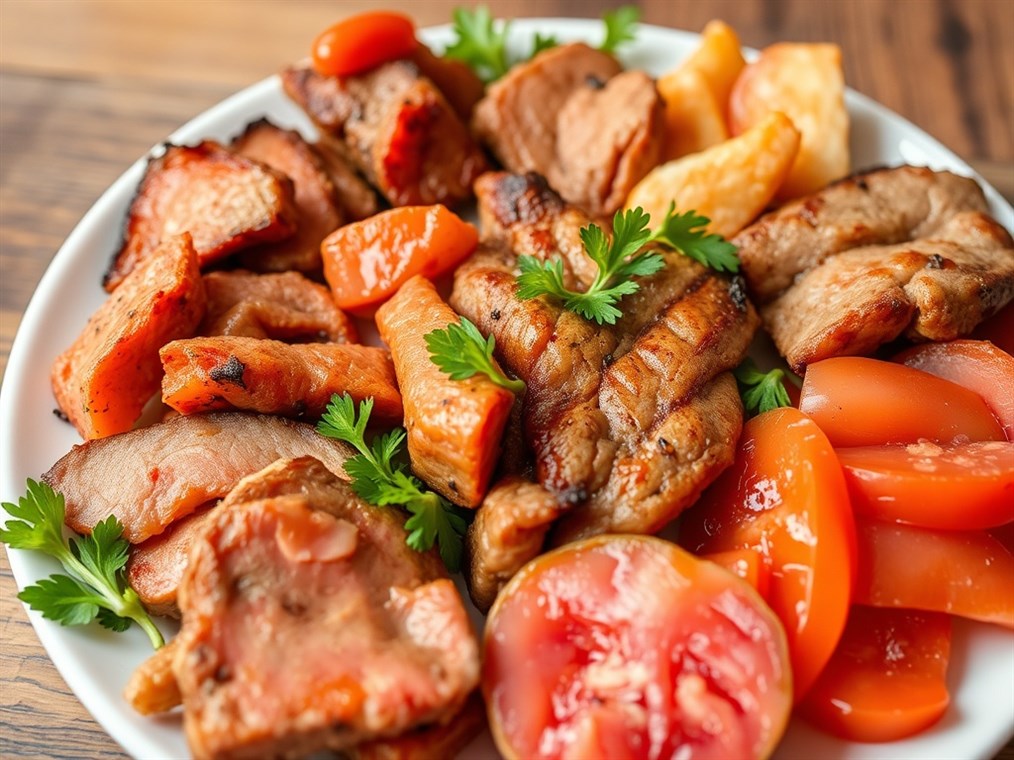How Much Meat Should You Really Be Eating? Let’s Talk Serving Sizes
Okay, let’s get real about meat. We all know it’s packed with good stuff – protein for those muscles, iron to keep your energy up, and a bunch of B vitamins that are basically brain food. But figuring out how much to actually put on your plate? That’s where things get a little fuzzy. I mean, who walks around with a food scale, right? So, how do you enjoy the benefits of meat without going overboard? Let’s break it down.
The general rule of thumb? Aim for a serving of cooked lean meat, poultry, or fish that’s around 3 to 4 ounces. Think of it like this: it should be about the size of a deck of cards you’d use for poker night, or roughly the size of your palm. Easy peasy.
Now, the USDA (those folks who know their food) suggest tossing 2-3 servings of meat, poultry, eggs, or even beans and nuts into your daily diet. And down under, in Australia, their dietary guidelines recommend something similar: 1-3 servings of lean meat, poultry, fish, eggs, or plant-based protein sources each day. They even get specific, saying a standard serve of cooked lean red meat is about 65 grams – that’s around 90-100 grams raw. For chicken, it’s about 80 grams cooked (100 grams raw). The American Heart Association chimes in too, suggesting around 5 1/2 ounces of protein foods daily, with a 3-ounce serving of cooked lean meat, poultry, or fish being a good target.
But let’s be honest, eyeballing it is usually how it goes. So, here are some handy visual cues to keep in your back pocket:
- Deck of Cards: Yep, that trusty deck of cards is your friend. A serving of meat should be about that size.
- Your Palm: Use your palm (minus those fingers!) as a guide for both the size and thickness of the portion.
- Matchbox: Imagine a matchbox. One ounce of meat is roughly that size.
- Computer Mouse: This one’s a curveball, but a medium potato is about the size of a computer mouse. (Okay, that’s for the side dish, but hey, a balanced meal, right?)
Now, not all meat is created equal, so here’s the lowdown on different types:
- Red Meat: This is the one to watch. Try not to go over 12-18 ounces (cooked) per week. And when you do indulge, go for leaner cuts like sirloin or ground round.
- Poultry: Chicken and turkey are generally good choices, just try to skip the skin.
- Processed Meats: Bacon, sausage, ham, deli meats… These are the guys you want to keep to a minimum. They’re often loaded with salt and saturated fat.
Here’s a thought: think of meat as a supporting player in your meal, not the star of the show. Aim to fill most of your plate – about two-thirds – with veggies, fruits, whole grains, and beans. That’s where the real magic happens.
Look, we all know that too much of a good thing can be… not so good. Overdoing it on the meat, especially the red and processed kinds, has been linked to some health concerns: heart issues, an increased risk of type 2 diabetes, and even certain cancers. It’s often the saturated fat, the way we cook it (think high heat), and those sneaky additives in processed meats that can cause problems.
But hey, let’s not throw the baby out with the bathwater! When you eat it in moderation, meat can be a real asset to your diet. It’s a fantastic source of protein, which is crucial for, well, just about everything. Plus, it’s packed with iron, zinc, vitamin B12, and other goodies your body craves. And protein can even help you manage your weight by keeping you feeling full and helping you hold onto muscle.
So, how do you make sure you’re getting the good stuff without the bad? Here are a few pointers:
- Go Lean: Choose lean cuts of beef, veal, and lamb. When you’re buying ground beef, look for the lean kind.
- Trim the Fat: Before you cook, get rid of any visible fat and skin.
- Easy on the Processed Stuff: Seriously, those sausages and bacon are tempting, but try to limit them.
- Cook Smart: Grilling, roasting, or broiling are your friends. Skip the frying.
- Balance is Key: Veggies, fruits, whole grains… make them the foundation of your meals.
- Meatless Mondays (or Any Day!): Try swapping out meat for legumes, beans, or tofu a few times a week.
Just in case you’re a numbers person, here’s a quick conversion from ounces to grams:
- 1 ounce = about 28.35 grams
- 3 ounces = about 85 grams
- 4 ounces = about 113 grams
Alright, there you have it. By keeping serving sizes in mind and making smart choices about the types of meat you eat, you can enjoy all the benefits without the downsides. So, go ahead, enjoy that steak (in moderation!), and remember to load up on those veggies!

